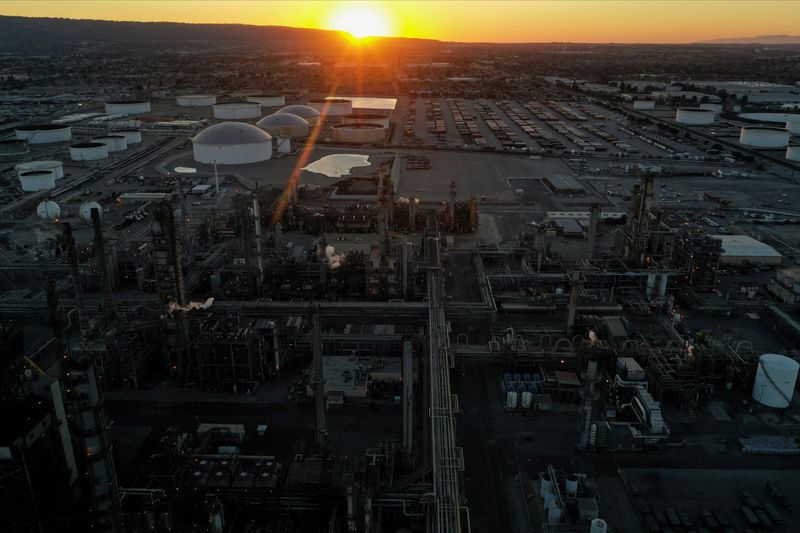Commodities
US oil refiners crank out diesel, further squeezing margins for gasoline


© Reuters. FILE PHOTO: A general view of the Phillips 66 Company’s Los Angeles Refinery, which processes domestic & imported crude oil into gasoline, aviation and diesel fuels, at sunset in Carson, California, U.S., March 11, 2022. Picture taken March 11, 2022. Pic
2/2
By Laura Sanicola and Stephanie Kelly
WASHINGTON (Reuters) – U.S. oil refiners have cranked up output of diesel, and jet fuel for winter but are struggling to turn a profit because gasoline margins have fallen over 80% since the summer driving season ended.
Refiners, which typically produce more distillates such as diesel and heating oil in autumn, are trying to rebuild inventories of these fuels that are near seasonal record lows.
While fuel makers focus on maximizing distillate output, they inevitably produce gasoline as well. That has left gasoline stockpiles bloated at a time of slow demand.
Meanwhile, Russia’s short-lived diesel export ban, along with less refinery capacity and Western sanctions on Russian diesel, have hit diesel inventories and tightened supplies.
U.S. distillate fuel oil inventories in September averaged 21 million barrels below the prior 10-year seasonal average, while European distillate inventories were 25 million barrels, below and Singapore distillate stocks averaged 3 million barrels below their respective averages.
Shortages have kept the U.S. heating oil crack at near $44 a barrel, nearly twice the seasonal average.
In the U.S., demand for distillates rose to its highest in a year last week.
Diesel and heating oil exports from U.S. refineries surged to 6.6 million barrels in September, the most in more than a year, according to LSEG data.
While four week average of U.S. exports of petroleum products rose to 6.3 million bpd in the week ending Oct. 13, near its all-time high reached this summer, diesel exports are below the 10 year seasonal average, EIA data shows.
Gasoline prices have fallen about 30 cents in the past month to $3.58 a gallon, according to the AAA. That is below the near $4.00-per-gallon average just weeks ago, a threshold that tends to weigh on motorists’ minds and wallets.
A number of factors have influenced the drop in gasoline demand, including the end of the peak summer driving season, a string of storms in the U.S. East Coast that has kept drivers off the road, and the relatively high prices at the pump in the summer.
Gasoline inventories are up 7.7% from the same period last year, but the four week average of U.S. gasoline demand is down 6%, according to the U.S. Energy Information Administration.
As a result, profit margins to produce gasoline from , known as the gasoline crack, have dropped by 83% since August to as low as $7.04 a barrel this month, according to LSEG data.
OVERALL REFINING MARGINS
The silver lining for oil refiners is a steep drop in prices of credits they need to purchase if they do not produce enough biofuels, in order to comply with U.S. environmental law.
U.S. fuelmakers sold off the credits called RINs to lock in profits after the spread between soybean oil futures and heating oil futures blew out in August to its widest in over a year, traders said.
Biomass-based (D4) RIN credits can be generated through production of fuels such as biodiesel and renewable diesel, which can be made with feedstocks such as soybean oil. D4 credits traded as low as 77 cents each this month, the cheapest since October 2020, before rebounding to 90 cents this week.
Commodities
Oil prices rise; U.S. crude inventories plunge, Russia-Ukraine truce eyed
Commodities
India’s Reliance to stop buying Venezuelan oil over US tariffs, sources say
Commodities
Oil prices climb on Venezuela supply worries

 Forex3 years ago
Forex3 years agoForex Today: the dollar is gaining strength amid gloomy sentiment at the start of the Fed’s week

 Forex3 years ago
Forex3 years agoUnbiased review of Pocket Option broker

 Forex3 years ago
Forex3 years agoDollar to pound sterling exchange rate today: Pound plummeted to its lowest since 1985

 Forex3 years ago
Forex3 years agoHow is the Australian dollar doing today?

 Cryptocurrency3 years ago
Cryptocurrency3 years agoWhat happened in the crypto market – current events today

 World3 years ago
World3 years agoWhy are modern video games an art form?

 Commodities3 years ago
Commodities3 years agoCopper continues to fall in price on expectations of lower demand in China

 Economy3 years ago
Economy3 years agoCrude oil tankers double in price due to EU anti-Russian sanctions

























